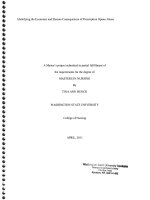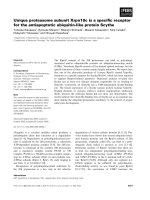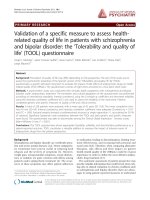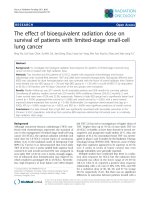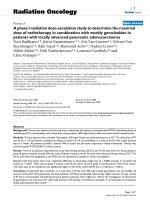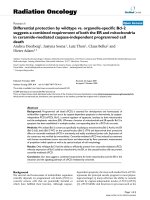Progression-free survival at 2 years is a reliable surrogate marker for the 5-year survival rate in patients with locally advanced non-small cell lung cancer treated with
Bạn đang xem bản rút gọn của tài liệu. Xem và tải ngay bản đầy đủ của tài liệu tại đây (359.39 KB, 5 trang )
Akamatsu et al. BMC Cancer 2014, 14:18
/>
RESEARCH ARTICLE
Open Access
Progression-free survival at 2 years is a reliable
surrogate marker for the 5-year survival rate in
patients with locally advanced non-small cell lung
cancer treated with chemoradiotherapy
Hiroaki Akamatsu1*, Keita Mori2, Tateaki Naito1, Hisao Imai1, Akira Ono1, Takehito Shukuya1,3, Tetsuhiko Taira1,
Hirotsugu Kenmotsu1, Haruyasu Murakami1, Masahiro Endo4, Hideyuki Harada5, Toshiaki Takahashi1
and Nobuyuki Yamamoto1,6
Abstract
Background: In locally advanced Non-Small-Cell Lung Cancer (LA-NSCLC) patients treated with chemoradiotherapy
(CRT), optimal surrogate endpoint for cure has not been fully investigated.
Methods: The clinical records of LA-NSCLC patients treated with concurrent CRT at Shizuoka Cancer Center
between Sep. 2002 and Dec. 2009 were reviewed. The primary outcome of this study was to evaluate the surrogacy
of overall response rate (ORR) and progression-free survival (PFS) rate at 3-month intervals (from 9 to 30 months
after the initiation of treatment) for the 5-year survival rate. Landmark analyses were performed to assess the
association of these outcomes with the 5-year survival rate.
Results: One hundred and fifty-nine patients were eligible for this study. The median follow-up time for censored
patients was 57 months. The ORR was 72%, median PFS was 12 months, and median survival time was 39 months.
Kaplan-Meier curve of progression-free survival and hazard ratio of landmark analysis at each time point suggest
that most progression occurred within 2 years. With regard to 5-year survival rate, patients with complete response,
or partial response had a rate of 45%. Five-year survival rates of patients who were progression free at each time
point (3-months intervals from 9 to 30 months) were 53%, 69%, 75%, 82%, 84%, 89%, 90%, and 90%, respectively.
The rate gradually increased in accordance with progression-free interval extended, and finally reached a plateau at
24 months.
Conclusions: Progression-free survival at 2 years could be a reliable surrogate marker for the 5-year survival rate in
LA-NSCLC patients treated with concurrent CRT.
Keywords: Locally advanced non-small cell lung cancer, Chemoradiotherapy, Surrogate endpoint, Overall response
rate, Progression-free survival
* Correspondence:
1
Division of Thoracic Oncology, Shizuoka Cancer Center, Shimonagakubo,
1007 Shimonagakubo, Nagaizumi-cho Sunto-gun, Shizuoka 411-8777, Japan
Full list of author information is available at the end of the article
© 2014 Akamatsu et al.; licensee BioMed Central Ltd. This is an open access article distributed under the terms of the Creative
Commons Attribution License ( which permits unrestricted use, distribution, and
reproduction in any medium, provided the original work is properly cited.
Akamatsu et al. BMC Cancer 2014, 14:18
/>
Background
Lung cancer is the most common type of cancer, both
worldwide and in Japan [1]. Non-small cell lung cancer
(NSCLC) accounts for 80-85% of lung cancer cases, and
approximately 30% of patients have unresectable, locally
advanced disease at diagnosis [2]. In the 1990’s, radiotherapy alone was recognized as the standard treatment, but
its efficacy was insufficient [3]. Sause et al., reported that
adding chemotherapy to radiotherapy brought further survival benefit [4]. A recent meta-analysis concluded that
concurrent chemoradiotherapy (CRT) is state-of-the art
treatment in this population [5,6].
The goal of CRT in locally advanced NSCLC (LANSCLC) is to cure. In the early period of treatment, tumor
shrinkage is an indicator of efficacy. Although concurrent
CRT provides a high rate of tumor response (60–70%), we
should take into account that it does not always mean
cure. Recent phase III trials of concurrent CRT reported
that two-thirds of patients who experienced complete, or
partial response eventually relapsed [7,8]. Another indicator of efficacy is progression-free survival (PFS). The
Kaplan-Meier curves of PFS in LA-NSCLC showed the
“infant mortality” type. This means that most progression
occurred in the first 2 to 3 years. Therefore, we speculate
that PFS rate at 2 years could be another candidate surrogate for cure.
Overall survival (OS) is the gold standard endpoint in
phase III trials. However, it requires long-term followup, and a large number of patients. Overall response rate
(ORR), median PFS, and PFS rate at specific time points
were commonly adopted primary endpoints in phase II
trials. However, their surrogacy for cure has not been
fully investigated. The aim of this study is to search for
the optimal surrogate marker of the 5-year survival rate
in patients with LA-NSCLC treated with CRT.
Methods
Page 2 of 5
in 2-Gy fractions over 6 weeks. Our radiation technique
was based on elective nodal irradiation. The radiation
fields contained the primary tumor, ipsilateral hilum,
and mediastinal nodal areas from the paratracheal to
subcarinal lymph nodes. The contralateral hilum was
not included, and the supraclavicular areas were not
routinely treated.
Assessment of outcomes and statistical analysis
Tumor response was classified in accordance with the Response Evaluation Criteria for Solid Tumors (RECIST),
ver. 1.1. In almost all patients, tumor response was
assessed every 2 courses of chemotherapy. After the treatment period, chest computed tomography (CT) was done
every 2 to 3 months during the first year and at 3 to 6
month intervals thereafter. Positron emission tomography
(PET) or PET-computed tomography (PET-CT) using
2-[18 F]-fluoro-2-deoxy-D-glucose (18 F-FDG) was performed at 6 to 12 month intervals if available. Magnetic
resonance imaging (MRI) of the brain was performed only
when clinical signs and symptoms suspicious for brain involvement were present. PFS was assessed from the first
day of treatment with CRT to the earliest signs of disease
progression as determined by CT or MRI imaging using
RECIST criteria, or death from any cause.
The primary outcome of this study was to evaluate the
surrogacy of ORR and PFS rate at 3-month intervals
(from 9 to 24 months after the initiation of treatment)
for the 5-year survival rate. Landmark analyses were performed to assess the association of these outcomes with
the 5-year survival rate.
A p value of < 0.05 indicated statistical significance.
The Kaplan-Meier method was used to estimate survival
as a function of time. All the analyses were performed
using JMP ver. 7 (SAS Institute Inc, USA) or R ver. 2. 15. 1.
This retrospective analysis was approved by the institutional review board of Shizuoka Cancer Center.
Patient selection and treatment methods
We collected the clinical records of LA-NSCLC patients
treated with concurrent CRT at Shizuoka Cancer Center
between Sep. 2002 and Dec. 2009. The eligibility criteria
of this study was as follows: (1) histologically or cytologically proven NSCLC; (2) chemoradiotherapy naïve;
(3) age < 75 years; (4) Eastern Cooperative Oncology
Group Performance Status (ECOG PS) of 0 to 2; and (5)
treated with curative thoracic radiotherapy over 50Gy
concurrent with platinum doublet chemotherapy.
Treatment comprised concurrent CRT and subsequent
consolidation chemotherapy. Chemotherapy regimen
was selected at investigator’s discretion. The doses and
schedules were in accordance with the published reports
[7,9-12]. All patients were treated with a linear accelerator photon beam of 4 MV or more. The primary tumor
and involved nodal disease were to receive at least 60 Gy
Results
A total of 159 consecutive patients were enrolled in this
retrospective study. Baseline characteristics of the patients are summarized in Table 1. Median age was 64
years, 79% of patients were male, 75% were heavy
smokers, 56% had an ECOG PS of 0, 53% had adenocarcinoma, and 54% were stage IIIB. Treatment characteristics are shown in Table 2. The most common regimens
were carboplatin (CBDCA) plus paclitaxel, and cisplatin
(CDDP) plus S-1 (46 patients each), and the third most
frequent regimen was CDDP plus vinorelbine (VNR) (41
patients). The median radiation dose was 60 Gy (range,
52–74). The median follow-up time for censored patients was 57 months. At the time of analysis, 89 patients (56%) had died and 114 patients (72%) showed
disease progression.
Akamatsu et al. BMC Cancer 2014, 14:18
/>
Page 3 of 5
Table 1 Baseline characteristics
Characteristic
N = 159
Age-year
Median
64
Range
40-75
Sex-no. (%)
Male
Female
126
(79)
33
(21)
Smoking status
Non or light smoker
25
(16)
119
(75)
15
(9)
0
90
(57)
1
67
(42)
2
2
(1)
Heavy smoker
Unknown
ECOG performance status-no. (%)
Histology-no. (%)
ad
84
(53)
sq
54
(34)
Other
21
(13)
IIIA
86
(54)
IIIB
73
(46)
Clinical stage-no. (%)
Abbreviations: ECOG Eastern Cooperative Oncology Group, ad adenocarcinoma,
sq squamous cell carcinoma.
Complete response was observed in 6 patients, and
107 patients had partial response. Then, ORR was 72%
(95% confidence interval [CI]: 65–78). Figure 1 shows
Kaplan-Meier curves of PFS and OS. Median PFS was
12 months (95% CI: 10–14), and median OS was 39
months (95% CI: 30–46). Among 110 first relapse sites,
29 were loco-regional, 66 were distant, and 15 were
Figure 1 Kaplan-Meier-estimated PFS (dashed line) and OS
curve (bold line) in LA-NSCLC patients treated with concurrent
CRT (n = 159).
both. Of 114 relapsed patients, 89 (78%) received subsequent chemotherapy, and 58 (51%) received third line
chemotherapy. Six patients had epidermal growth factor
receptor (EGFR) mutation, and they all were treated with
gefitinib in a subsequent line. Six other patients demonstrated durable progression-free intervals (≥ 6 months)
with EGFR-tyrosine kinase inhibitors, but their EGFR
mutation status could not be assessed for lack of a sufficient specimen.
One hundred and forty-eight, 138, 121, 106, 101, 93,
87, and 79 patients who were alive at 9, 12, 15, 18, 21,
24, 27, and 30 months were included in the respective
landmark analysis. The hazard ratio (HR) of patients
who achieved progression-free to those who progressed
at each landmark analysis is described in Figure 2. HR
gradually decreased in accordance with progression-free
interval extended, and reached the lowest level at 24
Table 2 Treatment characteristics
Treatment
N = 159
Chemothrapy regimen-no. (%)
CBDCA + PTX
46
(29)
CDDP + S-1
46
(29)
CDDP + VNR
41
(26)
MVP
14
(9)
CBDCA + CPT-11
5
(3)
CDDP + VP-16
4
(2)
CDDP + VNR + DE-766
3
(2)
RT dose-Gy
Median
60
Range
52-74
Abbreviations: CBDCA carboplatin, PTX paclitaxel, CDDP cisplatin, VNR
vinorelbine, MVP mitomycin, vindesine, and cisplatin, CPT-11 irinotecan,
VP-16 etoposide, RT radiation therapy.
Figure 2 Hazard ratio of landmark analysis at each time point.
Dashed lines indicate 95% confidence intervals. Abbreviations: CR,
complete response; PR, partial response.
Akamatsu et al. BMC Cancer 2014, 14:18
/>
months (0.11; 95% CI: 0.05-0.24). Figures 1 and 2 suggest that an observational period of about 24 months is
sufficient to detect almost all recurrences.
Next, we examined the 5-year survival rates of patients
who achieved response or progression-free at each time
point. Among patients with complete response, or partial response, the 5-year survival rate was 45% (95% CI:
35–55) (Figure 3). The 5-year survival rates of patients
who were progression free at each time point (3-months
intervals from 9 to 30 months) were 53% (95% CI: 42–
64), 69% (95% CI: 57–79), 75% (95% CI: 62–84), 82%
(95% CI: 68–90), 84% (95% CI: 70–91), 89% (95% CI:
76–95), 90% (95% CI: 77–96), and 90% (95% CI: 77–96),
respectively. The rate gradually increased in accordance
with progression-free interval extended, and finally
reached a plateau at 24 months. Patients who maintained progression-free intervals longer than 24 months
had a 5-year survival rate of about 90%.
Discussion
In this study, 159 LA-NSCLC patients treated with concurrent CRT were analyzed to evaluate the surrogacy of
ORR and PFS rate at 3-month intervals for the 5-year
survival rate. Kaplan-Meier curve of progression-free
survival (Figure 1) and HR of landmark analysis at each
time point (Figure 2) suggest that most of progression
occurred in the first 2 years. Patients who maintained
progression-free intervals longer than 2 years had a 5year survival rate of approximately 90%, and the rate did
not increase thereafter (Figure 3).
Although ORR could be assessed in the early period of
CRT, its surrogacy for the 5-year survival rate has not
been fully evaluated. McAleer et al., did a combined analysis of two RTOG studies with CRT [13]. They reported
that response to induction chemotherapy was a possible
predictor of long survival (p = 0.06). Kim et al., also reported that responders demonstrated 5-fold long term
survival compared with non-responders among LA-
Page 4 of 5
NSCLC patients treated with CRT [14]. However, in
McAleer’s report, Kaplan-Meier curves of OS revealed
that 90% of responders died within 4 years. Furthermore,
Kim’s report was premature because the median followup time was only 489 days. Our analysis, with a longer
follow up period, demonstrated that the ORR was not a
favorable surrogate marker for the 5-year survival rate.
With regard to median PFS, Mauguen et al., conducted a meta-analysis of LA-NSCLC. They found a very
good correlation between median PFS and OS both at
the individual level and trial level (ρ2 range; 0.77-0.85,
R2 range; 0.89-0.97, respectively) [15]. However, it is
worth noting that their analysis contained relatively old
trials. The median survival time of 15 months reported
by Mauguen et al. was much shorter than that in a recent phase III trial, which reported a median survival
time of 29 months [16]. This prolongation of survival
may account for the development of post progression
therapy, as the median PFS did not differ between the 2
reports. This might be a cause for concern about the relationship between median PFS and OS. In fact, our analysis showed that the 5-year survival rates in patients
who were disease free at 9–12 months were only 5369%. The rate gradually increased in accordance with
progression-free interval extended, and reached a plateau at 90% after 24 months. This suggests that longer
progression-free period, not median PFS, is required to
identify cured patients.
The present study has several limitations. First, this
study contained various chemotherapy regimens, and
the timing of evaluatton depended on investigators because this was a retrospective study. Second, efficacy
results were slightly better than previous reports. In
our analysis, about 70% of patients were screened with
PET (or PET-CT) at diagnosis, and 3-dimensional conformal radiation therapy was adopted in all cases.
These contributed to accurate staging, and proper radiation therapy. In addition, the proportion of patients
who received post progression therapy was very high
(approximately 80%).
Conclusion
Our study suggests that PFS at 2 years could be a reliable
surrogate endpoint for 5-year survival rate in LA-NSCLC
patients treated with concurrent CRT. Further analysis is
warranted using prospective datasets.
Competing interest
The authors declare that they have no competing interests.
Figure 3 Five-year survival rates of patients who achieved each
outcome. The bars indicate 95% confidence intervals.
Authors’ contributions
HA contributed to the drafting of this manuscript and data collection, and
KM, and TN contributed to the study design and statistical analysis. HI, TS, TT,
HK, HM, ME, HH, TT, and NY contributed to analysis of the data and
interpretation of the findings. All authors have read and approved of the
submission of the final manuscript.
Akamatsu et al. BMC Cancer 2014, 14:18
/>
Page 5 of 5
Acknowledgements
We thank Charles McKay who provided medical assistance.
13.
Author details
1
Division of Thoracic Oncology, Shizuoka Cancer Center, Shimonagakubo,
1007 Shimonagakubo, Nagaizumi-cho Sunto-gun, Shizuoka 411-8777, Japan.
2
Clinical Trial Management Department, Shizuoka Cancer Center,
Shimonagakubo, Nagaizumi-cho Sunto-gun, Shizuoka, Japan. 3Department of
Respiratory Medicine, Juntendo University, Hongou Bunkyou-ku, Tokyo,
Japan. 4Division of Diagnostic Radiology, Shizuoka Cancer Center,
Shimonagakubo, Nagaizumi-cho Sunto-gun, Shizuoka, Japan. 5Division of
Radiation Oncology, Shizuoka Cancer Center, Shimonagakubo,
Nagaizumi-cho Sunto-gun, Shizuoka, Japan. 6Third Department of Internal
Medicine, Wakayama Medical University, Kimiidera, Wakayama, Japan.
14.
15.
Received: 2 September 2013 Accepted: 9 January 2014
Published: 14 January 2014
16.
References
1. Jemal A, Bray F, Center MM, Ferlay J, Ward E, Forman D: Global cancer
statistics. CA Cancer J Clin 2011, 61:69–90.
2. Govindan R, Bogart J, Vokes EE: Locally Advanced Non-small Cell Lung
Cancer: The Past, Present, and Future. J Thorac Oncol 2008, 3:917–928.
3. Reinfuss M, Glinski B, Kowalska T, Kulpa J, Zawila K, Reinfuss K, Dymek P,
Herman K, Skolyszewski J: Radiotherapy for stage III, inoperable,
asymptomatic small cell lung cancer. Final results of a prospective
randomized study (240 patients). Cancer Radiother 1999, 3(6):475–479.
4. Sause W, Kolesar P, Taylor S, Johnson D, Livingston R, Komaki R, Emami B,
Curran W Jr, Byhardt R, Dar AR, Turrisi A: Final Results of Phase III Trial
in Regionally Advanced Unresectable Non-Small Cell Lung Cancer.
Chest 2000, 117:358–364.
5. Auperin A, Le Pe’choux C, Rolland E, Curran WJ, Furuse K, Fournel P,
Belderbos J, Clamon G, Ulutin HC, Paulus R, Yamanaka T, Bozonnat MC,
Uitterhoeve A, Wang X, Stewart L, Arriagada R, Burdett S, Pignon JP:
Meta-Analysis of Concomitant Versus Sequential Radiochemotherapy in
Locally Advanced Non–Small-Cell Lung Cancer. J Clin Oncol 2010,
28:2181–2190.
6. O’Rourke N, Roqué I, Figuls M, Farré Bernadó N, Macbeth F: Concurrent
chemoradiotherapy in non-small cell lung cancer. Cochrane Database
Syst Rev 2010, 16(6):CD002140.
7. Yamamoto N, Nakagawa K, Nishimura Y, Tsujino K, Satouchi M, Kudo S, Hida
T, Kawahara M, Takeda K, Katakami N, Sawa T, Yokota S, Seto T, Imamura F,
Saka H, Iwamoto Y, Semba H, Chiba Y, Uejima H, Fukuoka M: Phase III
study comparing second- and third-generation regimens with
concurrent thoracic radiotherapy in patients with unresectable stage III
non–small-cell lung cancer: West Japan Thoracic Oncology Group
WJTOG0105. J Clin Oncol 2010, 28:3739–3745.
8. Segawa Y, Kiura K, Takigawa N, Kamei H, Harita S, Hiraki S, Watanabe Y,
Sugimoto K, Shibayama T, Yonei T, Ueoka H, Takemoto M, Kanazawa S,
Takata I, Nogami N, Hotta K, Hiraki A, Tabata M, Matsuo K, Tanimoto M:
Phase III trial comparing docetaxel and cisplatin combination
chemotherapy with mitomycin, vindesine, and cisplatin combination
chemotherapy with concurrent thoracic radiotherapy in locally advanced
non-small-cell lung cancer: OLCSG 0007. J Clin Oncol 2010, 28:3299–3306.
9. Ichinose Y, Seto T, Sasaki T, Yamanaka T, Okamoto I, Takeda K, Tanaka M,
Katakami N, Sawa T, Kudoh S, Saka H, Nishimura Y, Nakagawa K, Fukuoka M:
S-1 plus cisplatin with concurrent radiotherapy for locally advanced
non-small cell lung cancer: a multi-institutional phase II trial (West Japan
Thoracic Oncology Group 3706). J Thorac Oncol 2011, 6(12):2069–2075.
10. Sekine I, Noda K, Oshita F, Yamada K, Tanaka M, Yamashita K, Nokihara H,
Yamamoto N, Kunitoh H, Ohe Y, Tamura T, Kodama T, Sumi M, Saijo N:
Phase I study of cisplatin, vinorelbine, and concurrent thoracic
radiotherapy for unresectable stage III non-small cell lung cancer.
Cancer Sci 2004, 95(8):691–695.
11. Naito Y, Kubota K, Nihei K, Fujii T, Yoh K, Niho S, Goto K, Ohmatsu H, Saijo
N, Nishiwaki Y: Concurrent chemoradiotherapy with cisplatin and
vinorelbine for stage III non-small cell lung cancer. J Thorac Oncol 2008,
3(6):617–622.
12. Nishimura Y, Harada H, Soejima T, Tsujino K, Hayakawa K, Kozuka T, Tanaka
M, Sasaki T, Yamamoto N, Nakagawa K: Phase II study of Nimotuzumab in
combination with concurrent chemoradiation therapy (CRT) in patients
with locally advanced Non-small Cell Lung Cancer (NSCLC). Int J Radiat
Oncol Biol Phys 2012, 84(3):S68.
McAleer MF, Moughan J, Byhardt RW, Cox JD, Sause WT, Komaki R:
Does response to induction chemotherapy predict survival for locally
advanced non-small cell lung cancer? Secondary analysis of RTOG
8804/8808. Int J Radiat Oncol Biol Phys 2010, 76(3):802–808.
Kim DW, Shyr Y, Shaktour B, Akerley W, Johnson DH, Choy H: Long term
follow up and analysis of long term survivors in patients treated with
paclitaxel-based concurrent chemo/radiation therapy for locally
advanced non-small cell lung cancer. Lung Cancer 2005, 50:235–245.
Mauguen A, Pignon JP, Burdett S, Domerg C, Fisher D, Paulus R, Mandrekar
SJ, Belani CP, Shepherd FA, Eisen T, Pang H, Collette L, Sause WT, Dahlberg
SE, Crawford J, O’Brien M, Schild SE, Parmar M, Tierney JF, Le Pechoux C,
Michiels S: Surrogate Lung Project Collaborative Group. Surrogate
endpoints for overall survival in chemotherapy and radiotherapy trials in
operable and locally advanced lung cancer: a re-analysis of meta-analyses
of individual patients’ data. Lancet Oncol 2013, 14(7):619–626.
Bradley JD, Paulus R, Komaki R, Masters GA, Forster K, Schild SE, Bogart J,
Garces YI, Narayan S, Kavadi V, Nedzi LA, Michalski JM, Johnson D, MacRae
RM, Curran WJ, Choy H: A randomized phase III comparison of standarddose (60 Gy) versus high-dose (74 Gy) conformal chemoradiotherapy
with or without cetuximab for stage III non-small cell lung cancer:
Results on radiation dose in RTOG 0617. J Clin Oncol 2013, 31(15):7501.
doi:10.1186/1471-2407-14-18
Cite this article as: Akamatsu et al.: Progression-free survival at 2 years is
a reliable surrogate marker for the 5-year survival rate in patients with
locally advanced non-small cell lung cancer treated with
chemoradiotherapy. BMC Cancer 2014 14:18.
Submit your next manuscript to BioMed Central
and take full advantage of:
• Convenient online submission
• Thorough peer review
• No space constraints or color figure charges
• Immediate publication on acceptance
• Inclusion in PubMed, CAS, Scopus and Google Scholar
• Research which is freely available for redistribution
Submit your manuscript at
www.biomedcentral.com/submit


